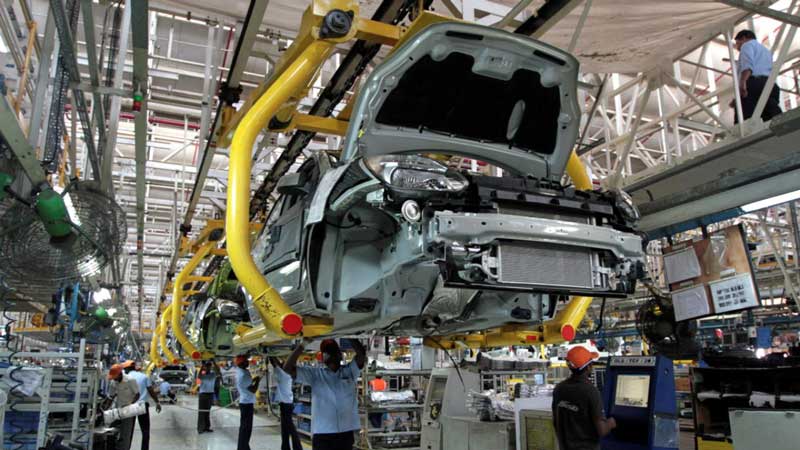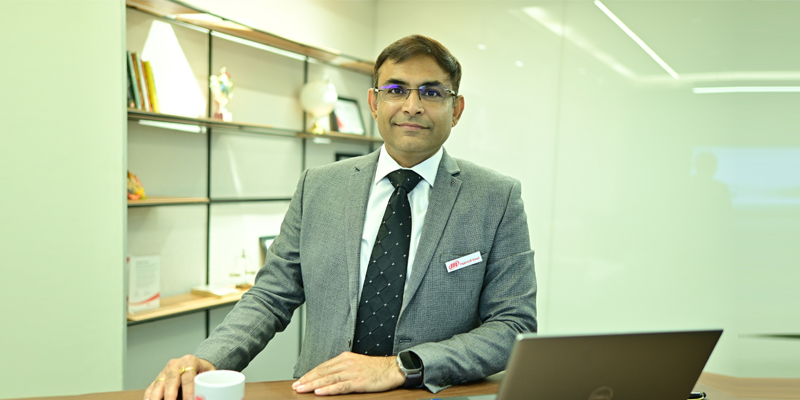Schedule a Call Back
Why India is the next big thing in manufacturing
 Articles
Articles- Apr 07,23

India’s exports (goods and services) are likely to touch $ 767 billion in the fiscal year 2022-23 (FY23) – up 14.5 per cent compared to $ 669.65 billion in FY22. Exports growth is commendable against the backdrop of slowdown witnessed in the global economy due issues such as Russia-Ukraine war, surging raw materials & energy prices, and, in general, the geopolitical tension between countries. “The global situation was not very much conducive to trade because interest rates have been firmed up and the demand has taken a little bit of a hit. Inflation is very high. Many of the advanced economies are facing a recession-like situation. The geopolitical situation also has affected and added to the uncertainty. Keeping in view global headwinds, this (India’s exports in FY23) is a good achievement as many countries have struggled to push their exports in such a difficult situation,” said Ajay Sahai, Director-General and Chief Executive Officer, Federation of Indian Export Organisations (FIEO), while to speaking to media.
India’s merchandise goods exports is estimated to be about $ 447 billion for FY 23 - recording a growth of 6 per cent over the last year’s (FY22) $ 422 billion, according to Piyush Goyal, the Minister of Commerce and Industry, Government of India (GoI). Service exports were expected to surpass $ 320 billion in 2022-23 – witnessing a robust 30 per cent over FY22. In FY22, USA, UAE, China, Bangladesh, and the Netherlands were the top five export destinations for India’s merchandise goods. In FY23, due to the changed geopolitical scenario, new opportunities had opened up in Russia and Europe for Indian goods.
India’s new Foreign Trade Policy
With an ambitious target to achieve exports of $ 2 trillion by 2030 (with goods & services making equal contribution of $ 1 trillion), India unveiled its Foreign Trade Policy 2023 (FTP2023) on March 31, 2023. Welcoming the FTP2023, Vinod Aggarwal, President, Society of Indian Automobile Manufacturers (SIAM) and MD & CEO, Volvo Eicher Commercial Vehicles (VECV), said, “Auto industry would get substantially benefitted from the new Foreign Trade Policy 2023 with measures such as, Self-Certification of Origin, reduction of threshold for Status Holders of Exporters, enabling Rupee payment and reduced export obligation under EPCG Scheme for electric vehicles. These measures will go a long way in propelling automobile exports from India, as Indian vehicle manufacturers are increasingly focusing on widening their exports footprint.”
To reach $ 2 trillion exports, merchandise and services exports will have to grow annually at 8-9.5 per cent and 16-17 per cent, respectively. “The 2.6-fold jump in exports between 2023 and 2030 charts an annual growth rate of 14.8 percent. Stepping back, FTA reimagines the India growth story through exports and powers exports built over trust and engagement with entrepreneurs and businesses,” stated Gautam Chikermane, VP of Observer Research Foundation (ORF), in her blog.
The new Foreign Trade Policy is duration-free in the sense that there is no end date to the FTP so that the Government of India can respond dynamically and responsively, as and when required. Sribash Dasmohapatra, Executive Director, Plastics Export Promotion Council (Plexconcil), elaborated, “With the new FTP in place, India will definitely reach its target of $ 1 trillion of merchandise exports and $ 1 trillion service exports by 2030. The move to make the new FTP a remission-based one (from incentive-based) was widely expected. However, the renewed thrust on emerging areas like e-commerce, streamlining of the SCOMET policy, provision for merchanting trade and encouraging overseas transactions in INR with an aim to make it a global currency are forward looking moves.”
Building manufacturing infrastructure
By 2030, 40 per cent of the Indians will be residing with a need for robust and sustainable infrastructure. As India marches ahead, from airports, high speed rails and metros, infra projects & complex data centers to booming industries, every facet of the country is transforming.
India has emerged as a globally competitive manufacturing hub and the sector represents one of the biggest opportunities to spur economic growth and job creation. To further boost manufacturing, the GoI in 2020 introduced the Production-Linked Incentive (PLI) scheme with an allocation of Rs 1.97 lakh crore ($ 27.02 billion) to create global manufacturing champions in 13 sectors (starting FY22). Hiren Pravin Shah, Executive Director & CEO, RePlus Engitech (a part of LNJ Bhilwara Group), elaborated, “Depending on the industry, each PLI programme is valid for a duration of four to six years. These industries include the automotive, drone, electronics, IT hardware, pharmaceutical, medical, and specialty steel markets. The PLI for semiconductor production has even been set at Rs 760 billion ($ 9.71 billion), with the goal of making India one of the world's top producers of this crucial component. India will enter a new level thanks to the semiconductor industry, where the nation will be seen as a manufacturing hub on a worldwide scale.”
Ravichandran Purushothaman, President, Danfoss India, added, “The manufacturing value chain is well poised to tap into market opportunities - export growth (export goods worth $ 1 trillion by 2030), import localisation, domestic demand, and contract manufacturing. This high-potential value chain can more than double its manufacturing GDP in a few years. The logistics costs are higher in India than our competitor countries like Taiwan, Thailand, Vietnam, Indonesia, and China. The PLI scheme will help us overcome this lag.”
Investing in manufacturing
Thanks to PLI scheme and the healthy economic growth, India received its highest-ever FDI (Foreign Direct Investment) of $ 84.84 billion in 2021-22 – showcasing the confidence of overseas investors in the country. For example, the Danish multinational company, Danfoss has invested approximately $300 million in India in the last two years and intends to invest more in the coming years. “If we sustain the current growth momentum of double-digit growth, we will see more investments coming from the Danfoss group. To tap the new opportunities, we have hired over 1,400 people in the technical domain during and after the pandemic to raise the headcount to around 3400. We are geared up to take a quantum leap, as far as Indian operations goes,” stated Ravichandran.
Similarly, Delta Electronics Inc, a Taiwanese electronics manufacturing company, is investing $500 million in India to develop its manufacturing capabilities for catering to exports and domestic markets. The company considers India as a pillar of its strategic long-term growth plans. Niranjan Nayak, Managing Director, Delta Electronics India, explained, “We believe India has a lot of potential and opportunity, and for Delta, we anticipate 20 per cent greater growth in India in 2023. We are very much aligned with Atmanirbhar Bharat. We are putting a lot of focus on increasing the localisation in India. In the next 1-2 years, we will make India an export hub for Delta worldwide. We wish to accelerate our top-line growth driven by key segments like EV, data centre, and industrial automation, which have abundant potential in India.”
Japanese electrical equipment company Fuji Electric is looking to further invest upto Rs 400 crore in India, over the next four years, to serve more Indian customers with its increased capacity and also explore opportunities to export made-in-India hardware to South East Asia, Middle East, Africa, Bangladesh, Sri Lanka, among others. Yosuke Ishizaka, Managing Director, Fuji Electric India, elaborated, “Large investments are happening in various sectors (in India) generating huge business opportunities. We have already surpassed Rs 1000 crores for the financial year 2022-23 and we are aiming at Rs 1500 crore in annual revenue in India by 2024. This is the fantastic time to be in the Indian market. The Indian economy is growing at a steady pace and the economic fundamentals are in place. The contribution of exports is 2 per cent at the moment but we aim to increase it to 10 per cent in coming years.”
Banking on India
India is an attractive hub for foreign investors in the manufacturing sector. Several mobile phone, luxury and automobile brands, among others, have set up or are looking to establish their manufacturing bases in the country. India is a land of opportunities for multinational companies (MNCs). Despite the challenges of working in India, MNCs are convinced of the long-term India opportunity, with its young and well-educated population, and its evolution as an IT and R&D powerhouse.
“The opportunity to Make in India, and to merge domestic production and consumption with global supply chains, make India an active manufacturing hub placed at the heart of global value chains. The ease of doing business, transparency, and e-governance have shown considerable improvement, and we see continued efforts to enhance skills development and technical training needs,” observed Georg Graf, Regional Representative for Freudenberg in India.
Indian manufacturing sector is also steadily moving toward a more automated and process-driven manufacturing, which is projected to raise the efficiency and boost production. “India is making progress toward Industry 4.0 thanks to government initiatives like the National Manufacturing Policy, which aims to raise manufacturing's GDP share to 25 per cent by 2025, and the PLI scheme for manufacturing, which was introduced in 2022 to bring India's core manufacturing sector up to par with international manufacturing standards,” explained Nayak.
With the world opting for China Plus One strategy, PLI scheme and other GoI initiatives (for various sectors) have came at the right time with the thought of promotion of exports and attracting the MNCs to set up establishments in India. PLI scheme provides the scope to scale up volumes by manifolds and increase local value-addition; thus, paving the way to create a robust supply chain in India. “India’s focus is for Atmanirbhar Bharat – Make in India to serve globally. India is bound to evolve as the country is becoming a China Plus One option for global players. With such measures coming to place, the efficiency of the manufacturing industry will increase and meet global standards, deliver quality products, with safety measures. With adoption of modern technologies like robotics and industrial automation, there would be no constraints in terms of skilled manpower, and the dependency will be reduced to manufacture efficiently and accurately,” stated Sangeet Kumar, Co-founder & CEO, Addverb Technologies - a global robotics company based out of India.
India rising
India’s exports have seen tremendous growth over the last two years reaching $ 418 billion of manufacturing exports in the fiscal year 2022. With impetus on developing industrial corridors, metros, new airports, high-speed trains and smart cities, India will witness unprecedented growth in manufacturing sector in this decade from 2025. India is well on its way to become most sought-after manufacturing destination in the world and has the potential to export goods worth $ 1 trillion by 2030. “Though India contributes 3.1 per cent of GDP, our export contribution to the world has been a mere 1.6 per cent only and looking at the current opportunities, it has immense scope, potential and triggers to grow. By 2028, it is expected that India will reach $ 1 trillion of manufacturing exports,” stated Niranjan Nayak.
Going by the strong foundation which the government is building in terms of high expenditure for developing modern infrastructure, internationalisation of trade, free trade agreements and growth in exports (goods and services), India’s GDP may reach $ 35-40 trillion by 2047. So, India clearly is a market to be in – currently and in the future.
Some of the macro trends in favour of India are:
The PLI schemes have been instrumental in forging the path ahead for India. The following illustrate a few areas where their presence has made a difference:
Courtesy: Bhavesh Thakkar, Partner (Tax and Regulatory), Indirect Tax, EY India
Related Stories

Ingersoll Rand aims to double India business in the next 5 years: Sunil Khanduja
In this interview, Sunil Khanduja, MD, Ingersoll Rand India, emphasises that the company is committed to India while supporting the country’s green and digital industrial transformation.
Read more
From oil & gas to hydrogen: The next big opportunity for Indian pipeline sector
India’s pipeline sector is on the brink of a historic transformation as it evolves from supporting oil and gas to becoming the backbone of the hydrogen economy, says Nikhil Mansukhani, MD, Man Ind..
Read more
Make in India in shifting world: Manufacturing for resilience, global leadership
India stands at a defining moment where disruption in global trade, technology, and supply chains offers both risks and opportunities for manufacturing-led growth. Rohit Chandra, Co-Founder & CEO, O..
Read moreRelated Products

Digital Colony Counter
Rising Sun Enterprises supplies digital colony counter.
Robotic Welding SPM
Primo Automation Systems Pvt. Ltd. manufactures, supplies and exports robotic welding SPM.

Heat Exchanger Scale Removal Compound -hesr-300
Hi There!
Now get regular updates from IPF Magazine on WhatsApp!
Click on link below, message us with a simple hi, and SAVE our number
You will have subscribed to our Industrial News on Whatsapp! Enjoy















